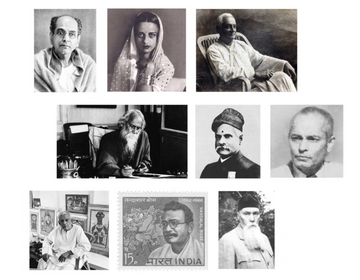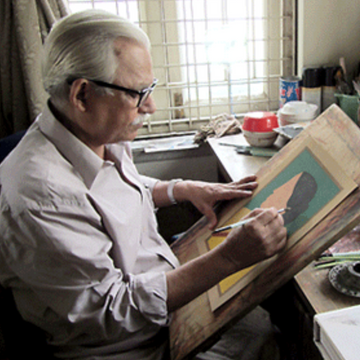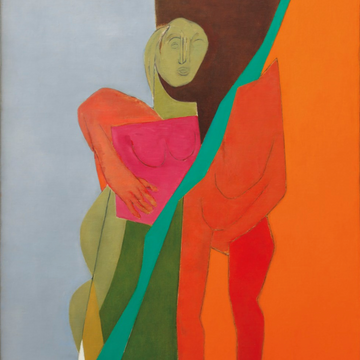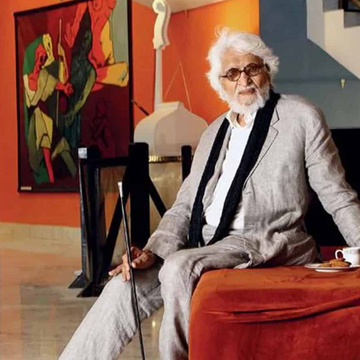Indian Navratna: 9 gems of Indian art

India, the land of colours, flavours and culture, has produced some extremely extraordinary artists over the years. These artists have preserved the culture and traditions of their homeland in their paintings and passed them on to the future generations. In the late 1970s, the Government of India, named the works by 9 Indian artists as ‘national treasure’. Though this was a huge honour for the artists, it also prohibited their sale beyond Indian borders, limiting their international recognition. For next few decades these artists were showcased only in government museums and few private collections. Here we take a closer look at the life and works of these ‘9 gems’ or navratna of Indian art world.
Abanindranath Tagore (1871 – 1951): Well known for his exponential work in inculcating Swadeshi or traditional values in Indian art, Abanindranath Tagore was the founder of the influential Bengal School of Art, that led to the promotion of modern Indian painting. He discouraged the Western influence on Indian art, and sought to modernise Mughal and Rajput miniature and other Indian and Oriental art forms, through his works. He found inspiration in murals at Ajanta, folk paintings, Japanese printmaking, Japanese-inspired wash, etc. A stunning combination of traditionalism and innovation, Abanindranath’s works resonate spirituality exclusive to India’s identity and his deep love and patriotism to his motherland.

“Journey’s End”, Abanindranath Tagore, circa 1913, tempera on paper. Image Source: Google_Art_Project[/caption]

Amrita Sher-Gil (1913–1941): Amrita Sher-Gil is one of the greatest avant-garde women artists of the early 20th century and is a pioneer in modern Indian art. She was born in an affluent family in Hungary, to an Indian Jat aristocrat who was also a Sanskrit and Persian scholar and a Hungarian-Jewish opera singer. Though European painting style, especially that from the post-impressionist era, influenced her art, she was very inspired by the Mughal miniatures along with the paintings on Ajanta caves. Though she traveled throughout her life, Amrita found a very special connection with India and Indian people. Here, she found her muse in ordinary Indian people and painted vivid paintings portraying their daily lives and activities. Often referred to as “Indian Frida Kahlo” Amrita’s legacy stands at par with that of the pioneers from the Bengal Renaissance.


Gaganendranath Tagore (1867–1938): The cofounder of the prestigious Bengal School of Art, Gaganendranath Tagore, was the elder brother of Abanindranath Tagore. Gaganenranath is recognised as a great pioneers of Indian art at the turn of the century, who was a painter and a cartoonist. Though he never received any formal education in art, Gaganendranath spent some time training under the watercolourist Harinarayan Bandopadhyay. Unlike his brother Abanindranath, Gaganendranath embraced the western art forms such as Cubism, Futurism and German Expressionism. Along with his exceptional paintings, Gaganendranath was also well received for his satirical caricatures of Indian politicians and Bengali people.
 Movement. Image Source: Invaluable[/caption]
Movement. Image Source: Invaluable[/caption]
Jamini Roy (1887–1972): Though formally trained in Western art, Jamini Roy changed his style to include Bengali folk art traditions in his paintings. He realised that rather than following the prevalent classical western styles, he should draw from inspiration and explore his own culture, folk and tribal art. Traditional Kalighat Pat paintings, that originated in 19th century in West Bengal, had a huge influence on Roy’s painting style. He enjoyed recreating the bold sweeping brushwork from Kalighat Pat style and soon parted ways from the impressionist portraits and landscapes. Throughout his life, Roy painted 20,000 paintings, which means he painted about 10 paintings everyday. Fondly remembered as ‘art machine’ Roy did not let the quantity compromise the quality of his works, his paintings are flawless and remarkable.
 Image Source: Christie's[/caption]
Image Source: Christie's[/caption]
Nandalal Bose (1882–1996): Renowned for his "Indian Style” of painting, Nandlal Bose is considered a pioneer of the Indian modern art and Contextual Modernism. His work was deeply impacted by the murals of Ajanta Caves. Bose was bestowed with the prestigious Padma Vibhushan and was splendidly asked by Jawaharlal Nehru to create emblem designs for Government of India’s awards; Padma Shri and Bharat Ratna. He has preserved Mahatma Gandhi’s arrest for protesting the British Tax on Salt, by making a black and white linocut print of that incident. Among many other artistic and historic ventures, Bose is remembered for embellishing and decorating the original manuscript of the Constitution of India.
 Image Source: Pundoles[/caption]
Image Source: Pundoles[/caption]
Nicholas Roerich (1874–1947): Though named as an Indian Treasure, Nicholas Roerich is the only artist, who is not from India. Born and brought up in Russia, Roerich was an artist, archaeologist, theosophist, writer and philosopher who was trained at the Academy of Art in St. Petersburg, Russia. He had a profound interest in Indian culture and settled down in Kulu Valley, after living in France and America, where he developed a deep spiritual connection with India. He was later recognised for his picturesque landscapes of snow laden Himalayan range painted in subtle pinks, vivid blues and radiant purples. His paintings were also deeply impacted by his study of Vedanta and Buddhism.


Rabindranath Tagore (1861–1941): Affectionately known as Gurudev, the Nobel Price Awardee, noted poet, writer and philosopher, Rabindranath Tagore, started painting much later in his life. Tagore is renowned for his work and deep influence on Bengali literature and music, along with Indian art and Contextual modernism between late 19th and early 20th centuries. At the age of 63, he turned towards paintings, changing his art form, from verse to colours. But even in a short tenure he experimented with a variety of mediums such as watercolours, inks, and crayons. Much like his medium, Tagore also had a vast liking for his subjects ranging between serene landscapes and exceptional portraits and human figures. Tagore was known for blending a variety of art forms and art movements in his works.

Raja Ravi Varma (1848–1906): Prominently known as the “Father of Indian Modern Art”, Raja Ravi Varma is one of the most celebrated artists in India. Though, Raja Ravi Varma was closely related to the royal family of Travancore, he was known as an artist of people. Varma combined European academic art with Indian art and culture. He was renowned for realistic recreations of Hindu deities, stories and incidents from ancient Indian history and Puranas on his canvas. He was the first Indian artist who made lithographs of his paintings, making fire art affordable and making it affordable for common people.

Sailoz Mookherjea (1906–1960): Sailoz Mookherjea was an early modernist who was known for his simplified forms, vigorous lines and dynamic movement. After receiving his diploma in Fine Arts from Government College of Arts and Crafts in 1937, Mookherjea moved to Paris, where he was influenced by, and adapted European artistic styles, however, this did not change his subjects; he continued exploring his bond with nature and rural Indian people and painted serene landscapes. Colours played a pivotal role in Mookherjea’s paintings and took precedence over art form.

Over the last few decades, these nava ratna have left a perennial impact on Indian art world and continue to guide and influence the talented artists succeeding them.














